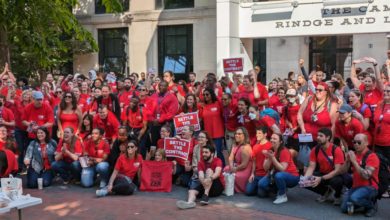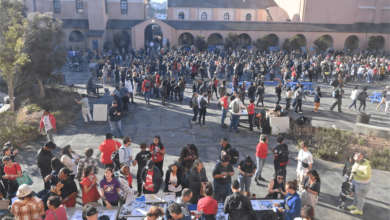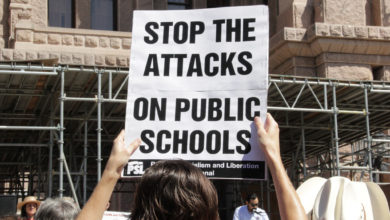The author was the Party for Socialism and Liberation’s 2020 presidential candidate.
As a direct beneficiary of affirmative action in university, I have always believed in the absolute necessity of that policy to help overcome historic and systematic racism in education, employment and housing, especially as it pertains to the Black, Latino and Native communities.
On Monday, the U.S. Supreme Court heard lengthy oral arguments in two cases seeking to wipe out affirmative action in higher education by banning race as a factor for admission. Questions by the racist super-majority — justices Roberts, Alito, Gorsuch, Thomas, Kavanaugh and Barrett — strongly indicated they will overturn yet another historic progressive social policy, coming on the heels of overturning Roe v. Wade and the ongoing evisceration of the Voting Rights Act.
The court is determined to destroy decades of social progress on all fronts, regardless of majority public opinion in the United States.
Starting in 1978, Supreme Court rulings chipped away at affirmation action in school admissions, but they still upheld the right of universities to use race as one factor to admit prospective students. The last such ruling to permit race was Grutter v Bollinger in 2003.
Now, the reactionary plaintiffs are asking the court to overturn Grutter and affirmative action once and for all.
The plaintiff is the same in both instant cases — Students for Fair Admissions v. President and Fellows of Harvard College, and Students for Fair Admissions v. University of North Carolina, et al. It argues that any consideration of race in a student’s admission is itself “racist” and violates the Constitution’s 14th Amendment guarantee of “equal protection under the law.”
Although Students for Fair Admissions claims members in the thousands, the actual person leading SFFA is not a student at all. He is Edward Blum, a notorious financier of racist court cases that have reached the Supreme Court before. In Shelby County v. Holder, for example, the 2013 ruling gutted the Voting Rights Act of 1965, exempting former Jim Crow states from “pre-clearance approval.” That process required certain states with a history of repressing Black voters to get federal approval before implementing any voting procedural changes.
Perhaps the most insulting of the plaintiffs’ argument is their use of the historic Brown v. Board of Education for their racist aims.
Turning reality on its head, the SFFA argues that the groundbreaking 1954 decision — ordering the desegregation of schools — was “race-neutral” by rejecting separate schools for Black and white children. But the whole premise of Brown as successfully argued by the NAACP, was that the deeply racist structure of segregated southern schools kept Black children in shockingly inferior conditions and they were harmed psychologically. The apartheid system was not race neutral by any means. And neither was the remedy in Brown.
Affirmative action was won through struggle
The 1960s and 1970s social struggles — for voting and civil rights, the fight to desegregate transportation and housing, the rise of the Black Panthers and Black liberation — also brought the demand for programs to right historical wrongs in education. The unwritten policies of most universities discriminated against Black and other youth of color and the curricula perpetuated white supremacist ideas.
Students began to organize on their campuses to demand affirmative action programs, including quotas to ensure that the universities fulfilled meaningful goals of recruitment and retention of students historically disadvantaged. Ethnic studies became a major flashpoint.
At San Francisco State University in 1968, a five-month militant student strike by the Black Student Union, the Third World Liberation Front and supporters led to SFSU establishing the first School of Ethnic Studies. Everywhere, students put their own education at risk to fight for future generations of students.
The Black students at Brandeis University in January 1969 took over the campus building of Ford Hall and held it for 11 days. Three months after the strike, Brandeis agreed to the students’ demand to establish the African and Afro-American Studies Department, one of the first in the country. They won many other demands as well, including scholarships for Black, Latino, Native and white disadvantaged students, and student recruiters to travel to cities to look for low-income students of color. To dispel the notion that only students with high test scores and grades “are capable” of attending university, Brandeis had the Transition Year Program that granted one year of tutoring and university classes with full tuition, and room and board to youth who had not completed high school. Many of my friends in TYP left Brandeis as college graduates.
That is how I was “found” and went to Brandeis, thanks to the Black students who began the struggle. As a young Chicana high school student in Albuquerque, I had not even heard of affirmative action. But in the spring of my senior year of high school in Albuquerque, a young Chicana student came to my school, where several of us were called into the counselor’s office. She said, “Apply to Brandeis, there are scholarships there.” Having no prospects of funds for college despite being accepted at two other schools, I took her up on that offer. I had high grades in high school, but my family did not have the money.
I was accepted with a 92% covered four-year scholarship. I quickly learned from my fellow students how my “fortune” came about, together with hundreds of other students at Brandeis. Simply, it was the organized and persistent struggle of Black students, who were later joined by Latino and Asian students. They put their own education on the line, even risking expulsion for their bold stance on behalf of other students.
Real opportunity and material support were key. But of course, no sooner were affirmative action programs implemented in the United States then those same universities began to roll back the gains. It was the same at Brandeis. It began to cut affirmative action. So, in the spring of my first school year, a few dozen students and I took over the administration building for a day in protest. A year and a half later, we held the fine arts building for six days to demand no cuts to affirmative action. In my first year, I realized the problem was the system and I needed to become a socialist.
SFFA falsely claims to represent Asian American communities’ interests
SFFA claims that Asian Americans and white students are discriminated against by race considerations for Black and other students of color. It is a long-used tactic to try to divide and pit communities against each other.
An Amicus Curiae brief was jointly filed by the National Asian Pacific American Bar Association and the National LGBTQ+ Bar Association backing affirmative action. NAPABA says in part, “Petitioner attempts to characterize Asian Pacific Americans as victims of race conscious admissions programs, but Asian Pacific Americans in fact strongly support race-conscious admissions programs and the benefits of diversity in the educational environment.
“It is, of course, important to recognize that the Asian Pacific American community is broad and diverse, with individuals representing over fifty ethnic groups from across Central, East, and South Asia, the Pacific Islands, and Native Hawaiian communities. Despite this diversity, polling and voting data consistently shows broad and majority Asian Pacific American support for race-conscious admissions policies.”
The lie of color blindness and race neutrality
Formally declaring equality without remedies to make it so, employing “color-blind” criteria — these do not assure equality. It really perpetuates the inequality that exists in society overall, inequality that is becoming more profound under capitalism.
SFFA’s proposal for a “race neutral” alternative at Harvard was dispelled in yesterday’s oral arguments by Seth Waxman, attorney for Harvard. Citing the District Court’s finding, Waxman showed that the SFFA’s “race-neutral Simulation D plan” would cut the number of Black students admitted to Harvard from 14% of the study body, to only 6% to 10%.
In other words, a favorable ruling for SFFA v. Harvard is calculated to cut Black student enrollment in half!
The Supreme Court’s sweeping agenda includes more racist and anti-worker rulings in the pipeline. For example, the Indian Child Welfare Act of 1978 gives priority to Native families and nations to adopt Native children who are orphaned. White plaintiffs in the ICWA case argue that giving Native nations the right to preferential adoption of a Native child is racist because it considers race in placing the child with their community!
Such unprecedented attacks must help set the stage for a national, broad-based fight against the white supremacist court and to defend the people’s democratic rights.






